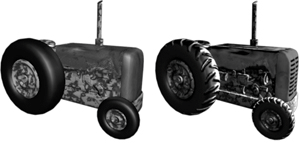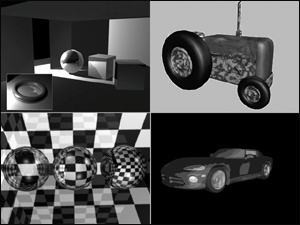Chapter 16. Cameras and Rendering
|
| Creating quality images in Maya, whether for print or video, depends on renderingthe process of creating an image (or sequence of images) from a scene. When you render, you create a two-dimensional image from a specified three-dimensional view of your scene. Maya makes intensive mathematical calculations and applies the laws of physics to realistically create lighting, shadows, reflections, and textures. With a few settings, you can take even a very simple scene and make it look realistic by rendering it. Rendering lights, shadows, and textures is performed using software rendering. Maya also performs hardware rendering, which is essentially what you see in your Perspective view and is greatly enhanced by your computer's display card. When you press Figure 16.1. Compare a hardware render of a tractor (left) with a software render (right). The software render has a bump map that forms the tire treads and a transparency map that creates the grill in the front. Maya has a unified Render Globals window to help set render qualities for the Hardware Renderer, Vector Renderer, and Mental Ray Renderer, as well as the Software Renderer. These rendering technologies, combined with the unified Render Globals window, makes Maya a powerful rendering and animation program (Figure 16.2). Figure 16.2. These renderings were created with Maya's rendering technologies: Mental Ray (upper left), Hardware Renderer (upper right), Software Renderer (lower left), Vector Renderer (lower right). |
|

